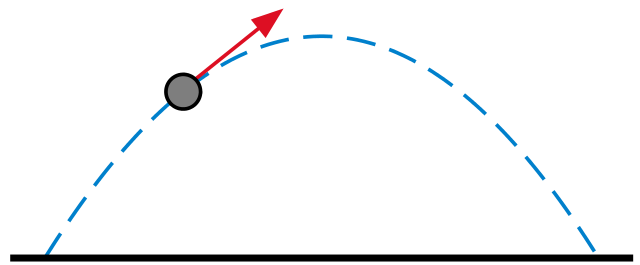% illustration of a parabolic trajectory
function main()
L=0.8;
s=0.1;
q=-0.4;
N=100;
arrow_size = 0.1;
sharpness = 20;
arrow_type = 1;
arrlen = 0.3; % arrow length
tiny = 0.01;
ball_radius = 0.05;
X=linspace(-L, L, N);
Y =L^2 - X.^2;
Xl = linspace(-L-s, L+s, N);
% KSmrq's colors
red = [0.867 0.06 0.14];
blue = [0, 129, 205]/256;
green = [0, 200, 70]/256;
yellow = [254, 194, 0]/256;
white = 0.99*[1, 1, 1];
black = [0, 0, 0];
gray = 0.5*white;
lw = 2.3;
figure(1); clf; hold on; axis equal; axis off;
plot(X, Y, 'linewidth', lw, 'linestyle', '--', 'colour', blue);
arrow([q-tiny, L^2-q^2], [q+arrlen-tiny, L^2-q^2-2*q*arrlen], lw, arrow_size, sharpness, arrow_type, red);
ball(q, L^2 - q^2, ball_radius, gray)
plot(Xl, 0*Xl, 'linewidth', 2*lw, 'colour', black);
%saveas(gcf, 'Parabolic_trajectory.eps', 'psc2')
plot2svg('Parabolic_trajectory.svg');
function ball(x, y, radius, colour) % draw a ball of given uniform colour
Theta=0:0.1:2*pi;
X=radius*cos(Theta)+x;
Y=radius*sin(Theta)+y;
H=fill(X, Y, colour);
set(H, 'EdgeColor', [0, 0, 0]);
function arrow(start, stop, thickness, arrow_size, sharpness, arrow_type, colour)
% Function arguments:
% start, stop: start and end coordinates of arrow, vectors of size 2
% thickness: thickness of arrow stick
% arrow_size: the size of the two sides of the angle in this picture ->
% sharpness: angle between the arrow stick and arrow side, in degrees
% arrow_type: 1 for filled arrow, otherwise the arrow will be just two segments
% color: arrow colour, a vector of length three with values in [0, 1]
% convert to complex numbers
i=sqrt(-1);
start=start(1)+i*start(2); stop=stop(1)+i*stop(2);
rotate_angle=exp(i*pi*sharpness/180);
% points making up the arrow tip (besides the "stop" point)
point1 = stop - (arrow_size*rotate_angle)*(stop-start)/abs(stop-start);
point2 = stop - (arrow_size/rotate_angle)*(stop-start)/abs(stop-start);
if arrow_type==1 % filled arrow
% plot the stick, but not till the end, looks bad
t=0.5*arrow_size*cos(pi*sharpness/180)/abs(stop-start); stop1=t*start+(1-t)*stop;
plot(real([start, stop1]), imag([start, stop1]), 'LineWidth', thickness, 'Colour', colour);
% fill the arrow
H=fill(real([stop, point1, point2]), imag([stop, point1, point2]), colour);
set(H, 'EdgeColor', 'none')
else % two-segment arrow
plot(real([start, stop]), imag([start, stop]), 'LineWidth', thickness, 'Colour', colour);
plot(real([stop, point1]), imag([stop, point1]), 'LineWidth', thickness, 'Colour', colour);
plot(real([stop, point2]), imag([stop, point2]), 'LineWidth', thickness, 'Colour', colour);
end



